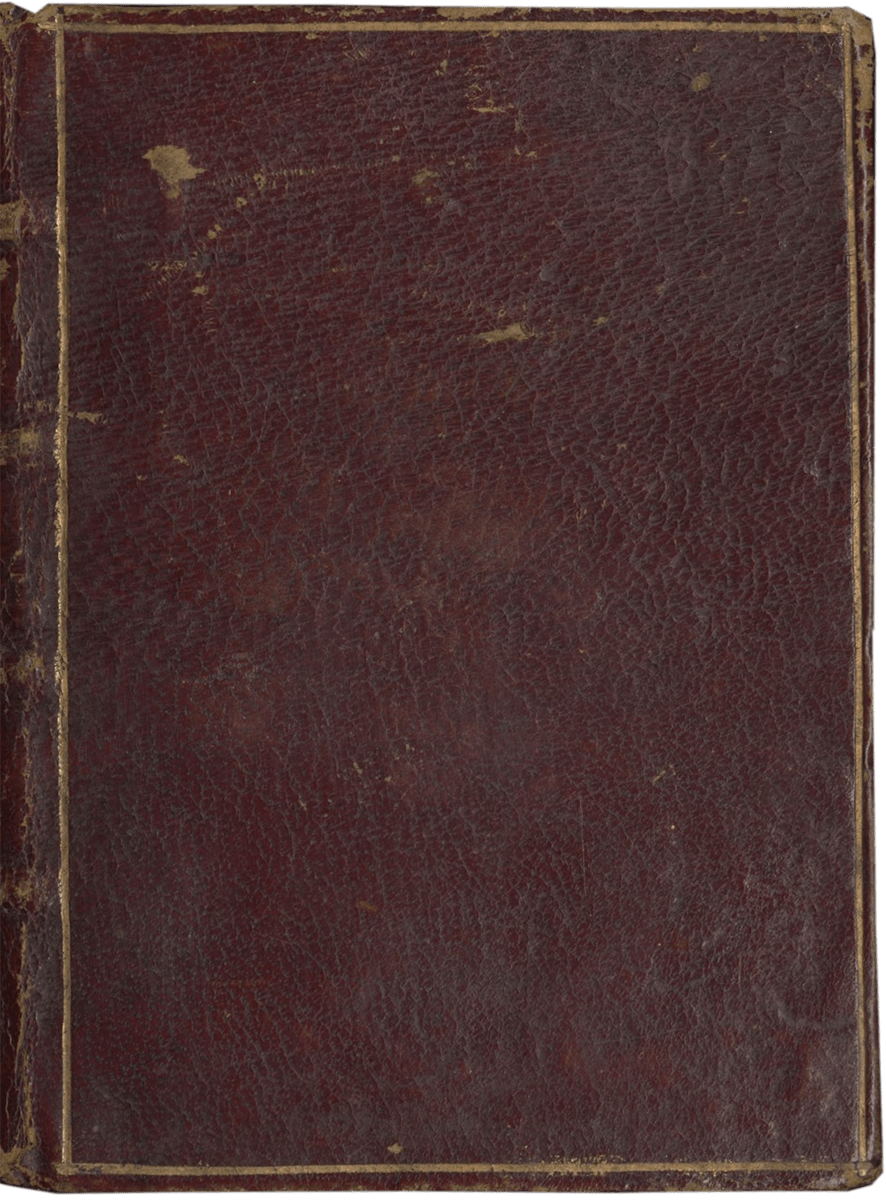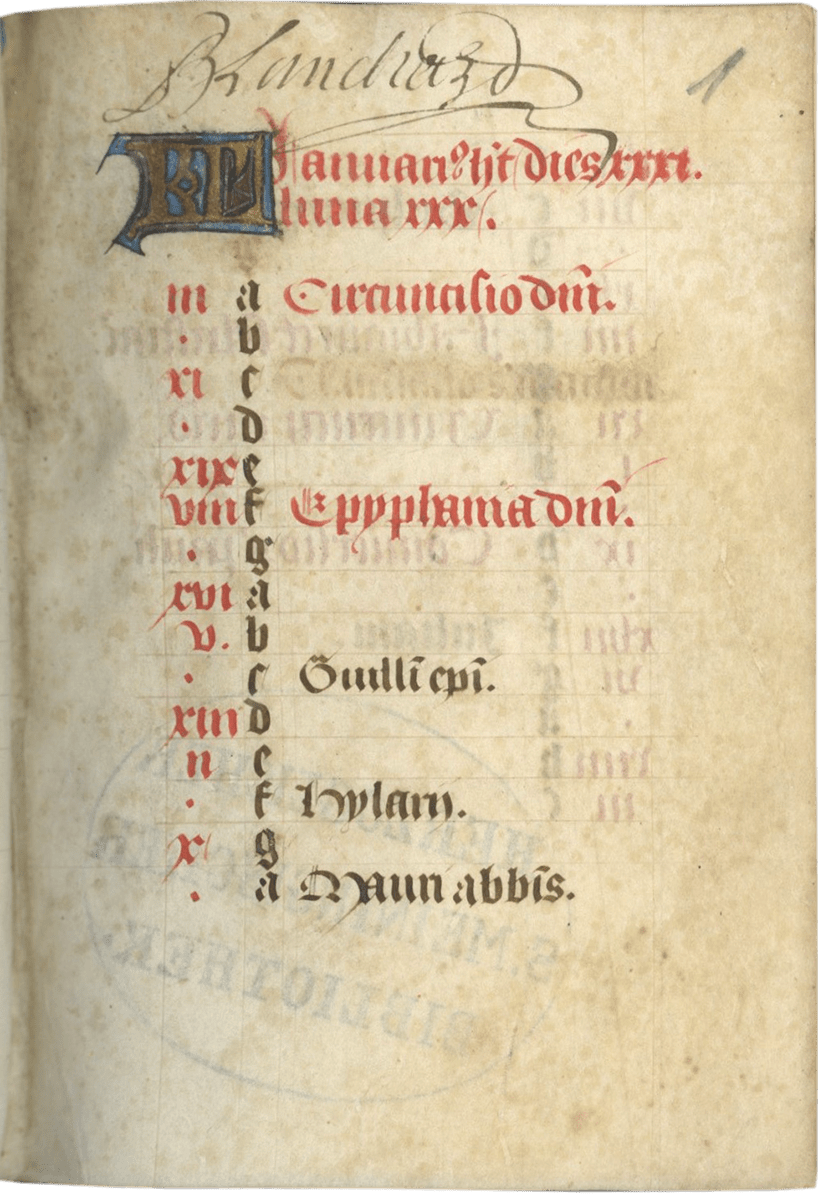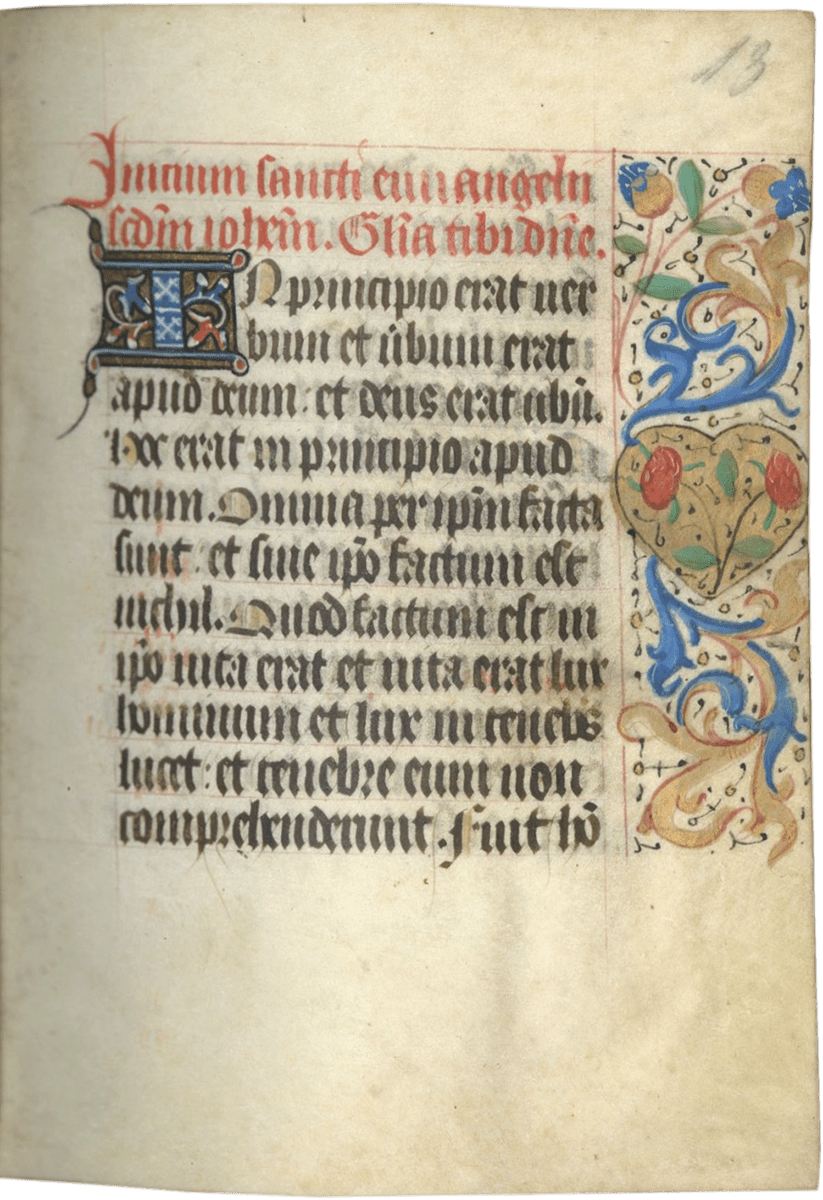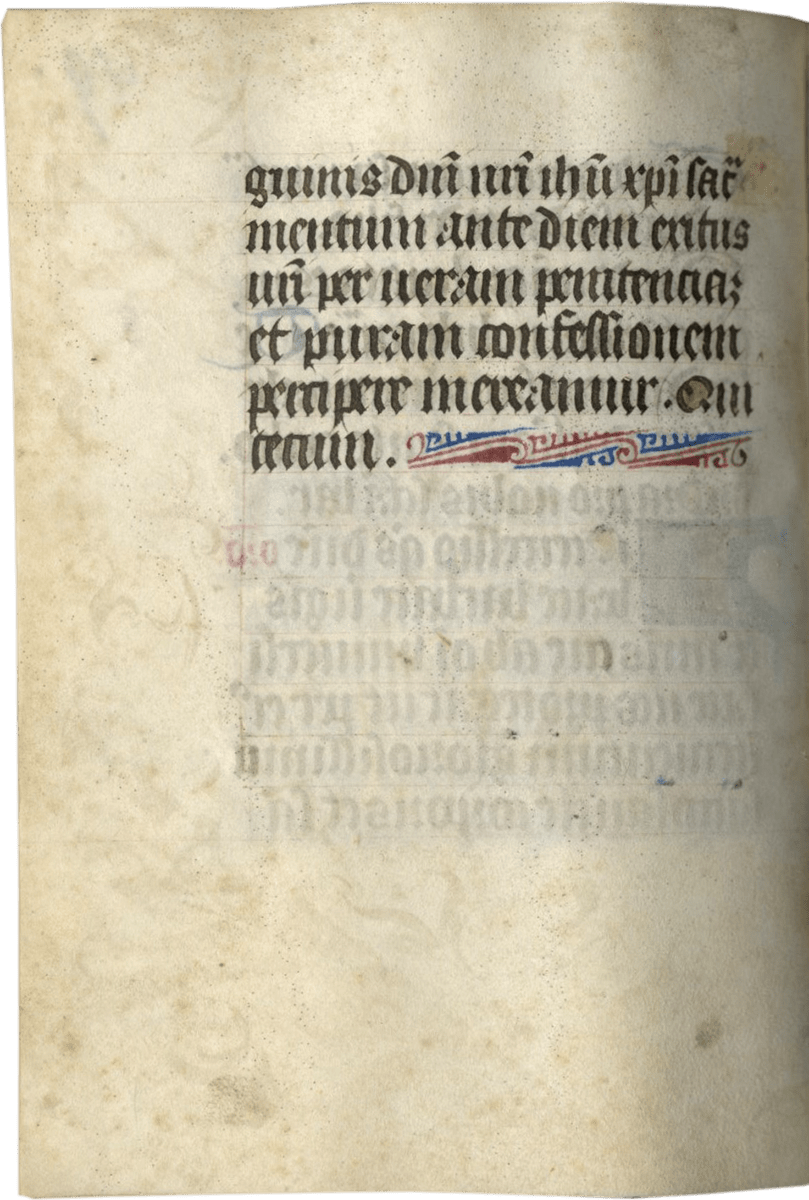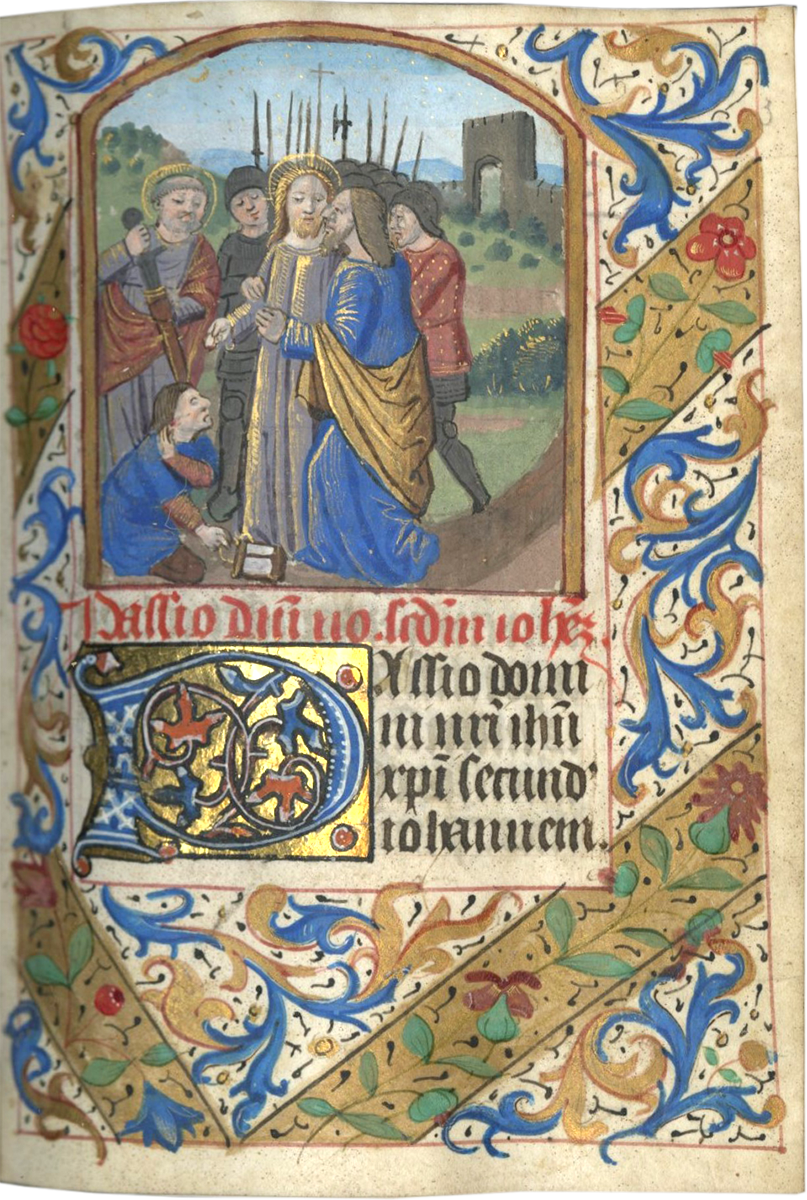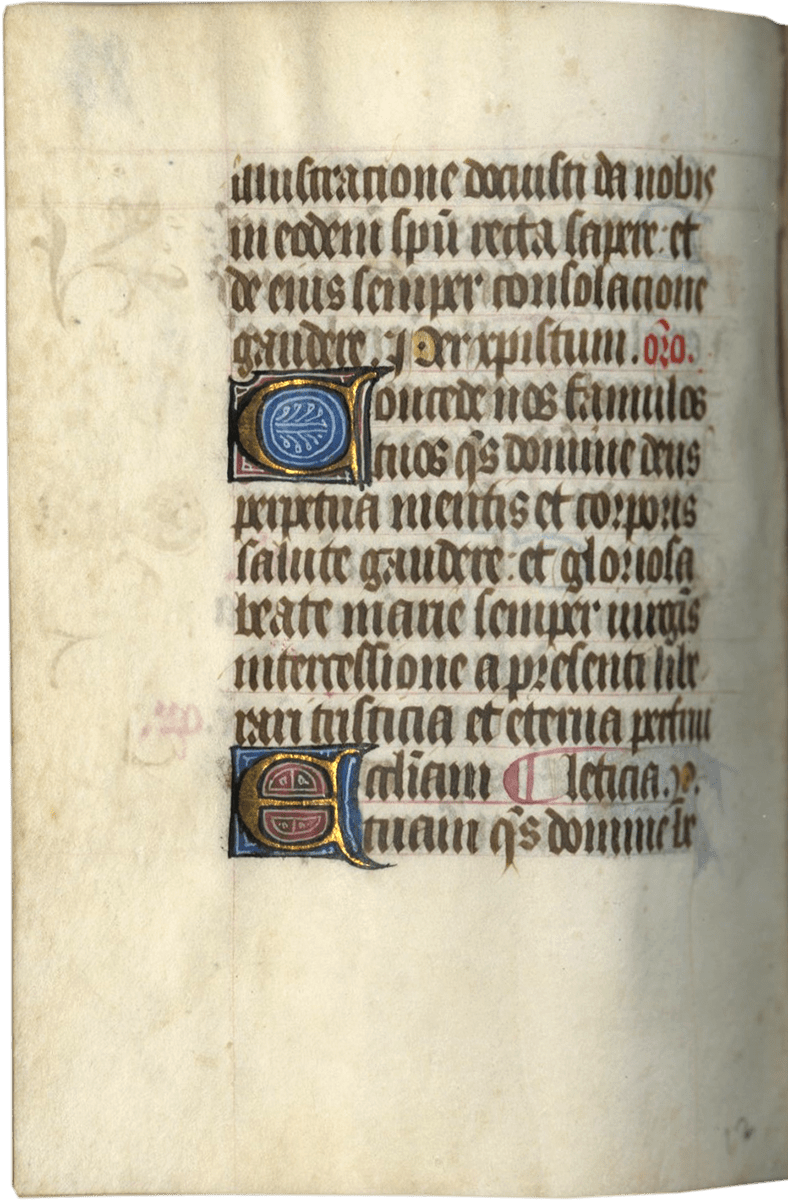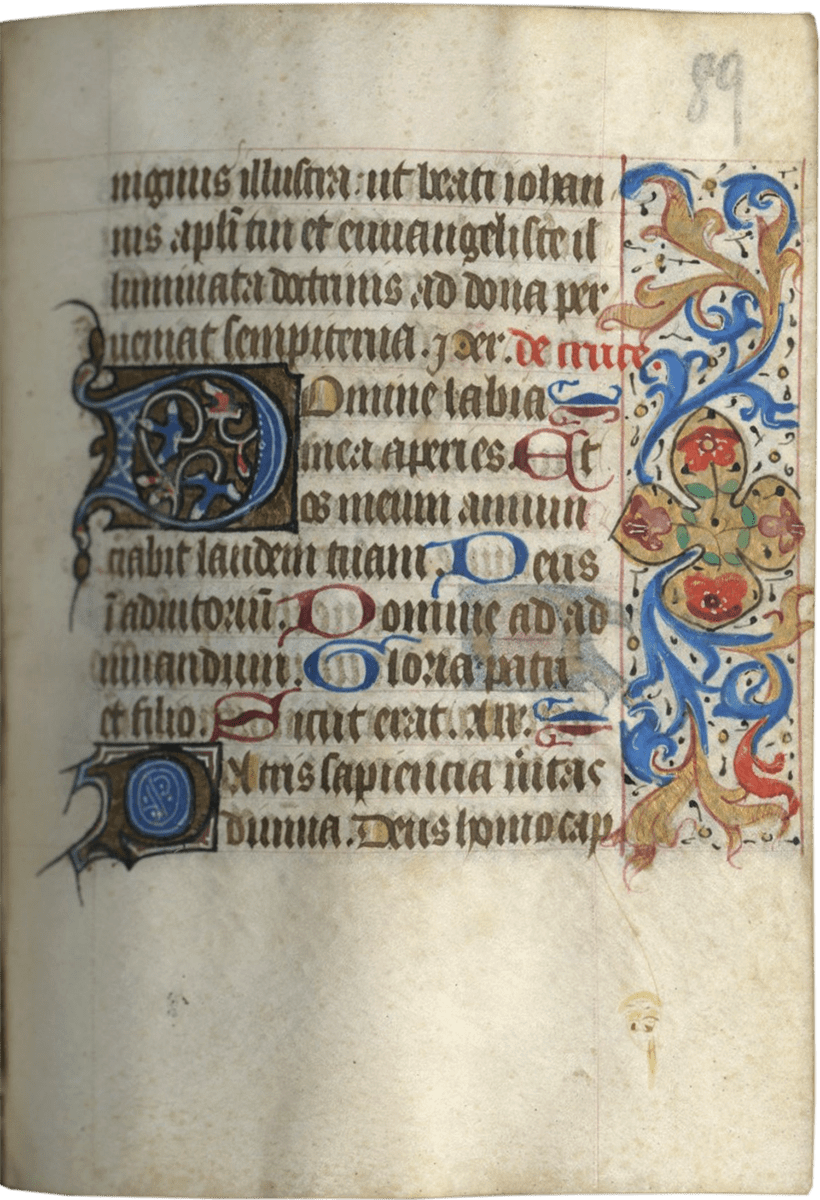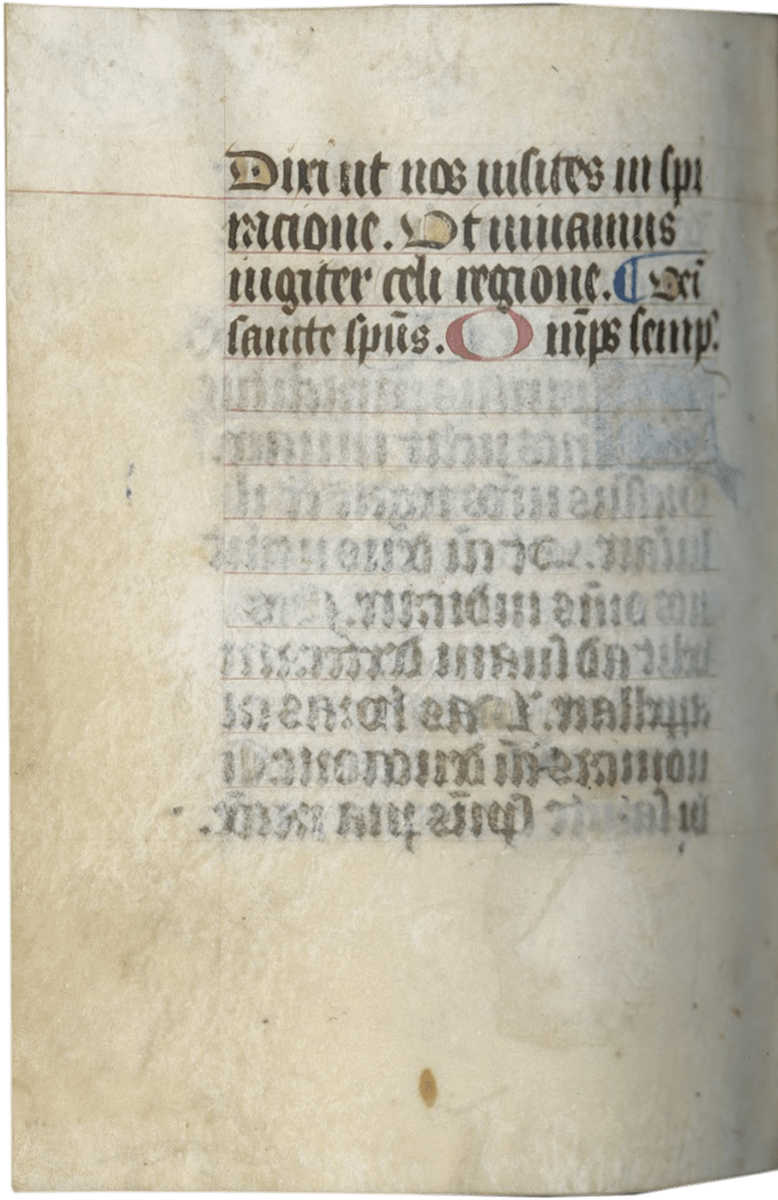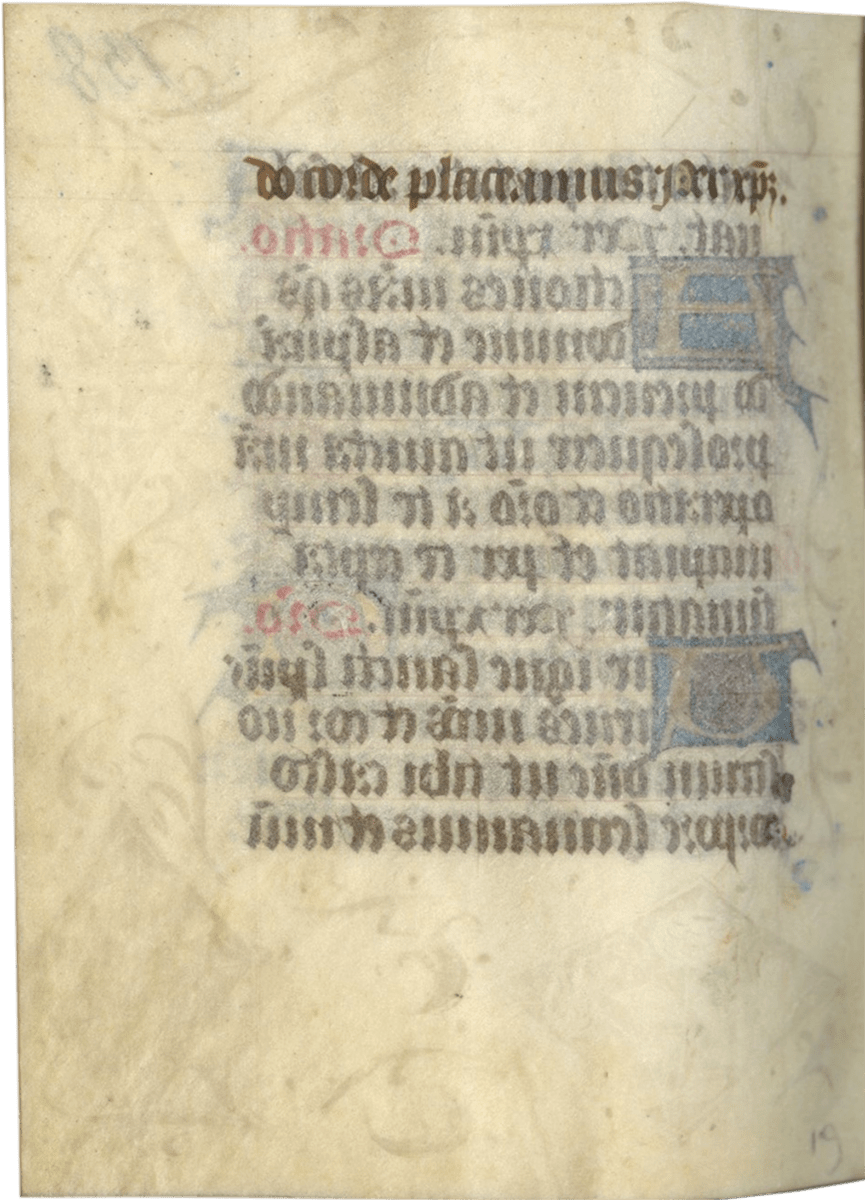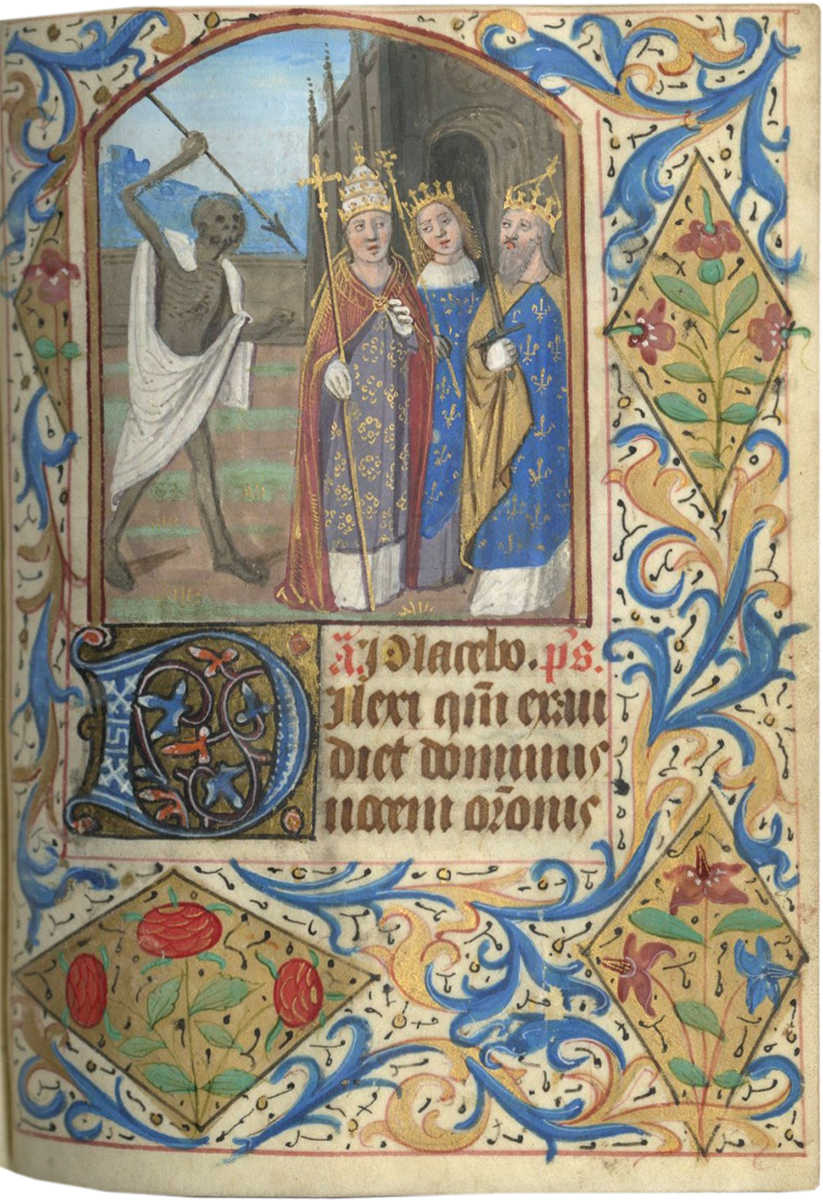


Book of Hours (Use of Chartres)
, France, Chartres, c. 1470-1480





Book of Hours (Use of Chartres)
Description
This modest Book of Hours was made for the use of Chartres as indicated by the calendar and litany. With illustrations at the opening of each of the major sections of text and attractive liquid gold floral and geometric borders, it survives as a good example of a modestly priced, though complete Horae, then as well as now. Manuscripts made in Chartres are rare because a fire devastated the city’s municipal library during the Second World War. This one preserves an unusually early “dance of death” iconography prefacing the short Office of the Dead.
ii + 158 leaves (3 blanks) + ii, incorrect modern foliation in pencil, evidence in the gutter that two leaves between ff. 23-24 have been excised, though not affecting text, otherwise complete, (collation: 1-26 3-48 51 <56 7-88 92 (9/2 blank)10-158 166 17-188 192 20 -218 224 (22/3 blank, without final blank 22/4), ruled in red ink (justification 112 x 75 mm, written in black in textualis bookhand on 13 lines, initials in red and blue, many two-line illuminated initials in gold on blue and red ground with white tracery, 12 three- and four-line initials in blue on gold ground, infilled with branchwork decoration and with outer panel border, 4 LARGE MINIATURES within arched compartments with full borders of acanthus leaves and colored flowers and fruit, a few small smudges, but overall in very nice condition. Bound in 18th-century red Morocco, gilt edges, some rubbing to covers and edges, remains of 18th-century paper label on the spine, but in sturdy condition otherwise. Dimensions 121 x 90 mm
Provenance:
1. The devotion shown in the calendar and litany suggest it was made for use in central France, most likely Chartres. The feast of St. Leobinus (d. 557) on March 14th and his translation on September 15th, along with the feast of St. Chéron on May 28th, are all recorded in red. Leobinus, or Lubin, was a farmhand-turned-monk who served as an early bishop of Chartres until his death in the 557. Chéron, or Caraunus, was an early Christian missionary and martyr who was killed in Gaul, near present-day Chartres. There are multiple legends about his life, which separately place him at either the end of the 1st century or sometime in the 5th to 6th centuries. Both Leobinus and Chéron enjoy special veneration in Chartres and are depicted in the 13th century stained-glass windows in Chartres cathedral. Our manuscript’s calendar also includes the feasts of St. Arnulph of Tours and Metz (ca. 580-640) on July 18th in red. The feasts of William, Bishop of Bourges (died ca. 1209) on January 10th and Lupus, Bishop of Sens (died ca. 623) on September 1st, are likewise recorded in black. These feasts appear in the calendar of Oxford, Magdalen College, MS. Lat. 405; another Book of Hours made for use in Chartres, circa 1450-1475. Gregory Clark records these feasts as also appearing in a 1486 printed copy of the Breviarum Carnotense, or the Chartres Breviary, (Paris, BnF, Res. B 27931) in Appendix III of his Art in a Time of War. Leobinus also appears in the litany on f. 135v.
2. Meningen, Germany, Herzogliche Sachsen-Meiningische Bibliothek, MS 61, 19th century library stamps on the first fly leaf, f.2v, and f.157. The Ducal Saxony-Meiningen library was founded in 1680 by the Duke Bernhard I (1649-1706). Duke George I (1761-1803) opened his family’s library to the public after he came to power in 1782. When the German monarchy was abolished in 1918, much of the library’s collections were absorbed into the Thuringian State Archives in Meningen and some were sold.
3. London, Christie’s, Sale 5518, November 29, 1995, lot 10. The Schoenberg Database incorrectly records that this book has 157 leaves instead of 158, and 14 large miniatures, rather than 4.
4. Saint Louis, Missouri, Estate of Kenneth Fulbright Teasdale (d. 2023).
Text:
f. 1, ruled blank leaf;
ff. 2-13v, Calendar, with the feasts of important local saints Leobinus (March 14) and St. Chéron (May 28), along with the translation of Leobinus (September 15);
ff. 14-20v, Gospel Sequences;
ff. 21-25v, Obsecro te, masculine forms (et michi famulo tuo impetres);
ff. 25v-33, O intemerata;
ff. 33-43v, Prayers;
ff. 43v-50v, Suffrages;
ff. 51-64, Passion according to John;
f. 65, ruled blank leaf;
ff. 66-119v, Hours of the Virgin, ff. 66-78 Matins; ff.78v-92, Lauds; ff. 90-91, Hours of the cross; ff.91-92, Hours of the Holy Ghost; ff.92-98, Prime; ff. 98-102, Terce; ff. 102-105v, Sext; ff. 106-109v, None, ff.110-113v, Vespers; ff.113v-119v, Compline;
ff.120-133v, Seven Penitential Psalms;
ff. 133v-139v, Litany, including St. Leonibus on f. 135v;
ff.140-157, Office of the Dead, with three readings;
ff. 158, ruled blank leaf
The present Book of Hours contains a combination of antiphons and capitula for prime and none that is unrecorded in the Drigsdahl database (prime: antiphon: O admirabile… , capitula: Paradise porta… ; none: antiphon: Ecce maria genuit… , capitula: Gaude maria virgo…). However, in our correspondence, Gregory Clark concluded that the inclusion of saints Leonibus and Chéron in red in the Calendar and in the Litany suggests that the book was very likely made for use in Chartres.
The study of Chartres’ manuscripts is complicated by the bombing of the city’s municipal library during the Second World War. Nearly half of the books from the city’s collection were destroyed during the war. Of the surviving books, many are now very badly burnt fragments, such as Chartres, Bibliothéque municipale, MS. 929; a Book of Hours for the Use of Rouen, c. 1470-1480 (see fig. 1).
Illustration
4 large miniatures, with margins decorated with acanthus foliage (in blue, green, and gold,) hiding strawberries, hearts, thistles, daisies, lilies, and many other species of flowers.
Subjects of the 4 large miniatures are:
f. 51, The Betrayal of Christ;
f. 66, The Annunciation;
f. 120, David with his harp at prayer before an altar;
f. 140, The Dance of Death, with Three Living and Death brandishing a spear.
The depiction of the Annunciation on f. 66 has some stylistic similarities to the same scene painted on f. 22 in Oxford, Magdalen College, Lat. MS 405. In both miniatures, Mary is shown in prayer, studying her book before a rich, red canopy with very fine gold designs painted into the drapery. Both miniatures skillfully employ thin, gold highlights to add a sense of fluid movement to the Mary’s clothing (see fig. 2). The Angel Gabriel and a small, white dove radiating holy light enter the scene from the right-hand side of the miniatures. While the modeling of the hands and faces are notably different and the miniatures were most likely painted by different artists, the similar composition that the two scenes share might be drawn from a common exemplar.
Our manuscript has notable similarities with the miniatures on f. 131 and f. 140 of BnF, MS lat. 1406; a separate Book of Hours commissioned for the Use of Chartres in the fifteenth century(see figs. 3 & 4). The similar facial types and drapery designs, particularly the use of small hatch marks in matte gold to imply volume, suggest that both the miniatures are by the same hand. We thank Dr. Gregory Clark for his expertise and assistance in describing this manuscript.
Literature
Clark, Gregory, Art in a Time of War: The Master of Morgan 453 and Manuscript Illumination in Paris during the English Occupation (1419-1435), Pontifical Institute of Mediaeval Studies, 2016.
Online Resources:
Bibliothéque national de France, MS lat. 1406, “Book of Hours Use of Chartres,”: https://gallica.bnf.fr/ark:/12148/btv1b100223791/f7.item.r=Heures%20de%20chartres
Chartres, Bibliothèque Municipale, MS. 929, “Book of Hours Use of Rouen,”: https://portail.biblissima.fr/ark:/43093/mdata41f844de8a9d97f2450902c492a37940347f2ae7
Chartres Cathedral Website, “An exceptional ensemble,”: https://www.cathedrale-chartres.org/en/cathedrale/monument/the-stained-glass-windows/an-exceptional-ensemble/
The Hours of the Virgin, “New Tests for Localization of the Hore Beate Marie Virginis,”: http://manuscripts.org.uk/chd.dk/use/hv_chdtest.html
“Libraries in Thuringia,”: https://fabian.sub.uni-goettingen.de/fabian?Bibliotheken_In_Thueringen
“Library of the Thuringian State Archive Meningen,”:https://fabian.sub.uni-goettingen.de/fabian?Thueringisches_Staatsarchiv_Meiningen
Oxford, Magdalen College Library, “Book of Hours,”: https://www.magd.ox.ac.uk/blog/books-of-hours/
Rediscovering the Manuscripts from Chartres, “The Fire and its Consequences,”: https://www.manuscrits-de-chartres.fr/en/fire-and-its-consequences
Rediscovering the Manuscripts from Chartres, “Recognize a Manuscript from Chartres,”:https://www.manuscrits-de-chartres.fr/en/recognize-manuscript-chartres
Schoenberg Database of Manuscripts https://sdbm.library.upenn.edu/
Stone, Allison. “Images of Medieval Art and Architecture France: Chartres” (Cathedral of Notre-Dame):
http://www.medart.pitt.edu/image/france/chartres/chartres-cathedral/windows/choir-windows/015A-Cheron/chartres-15ACheron-main.html
